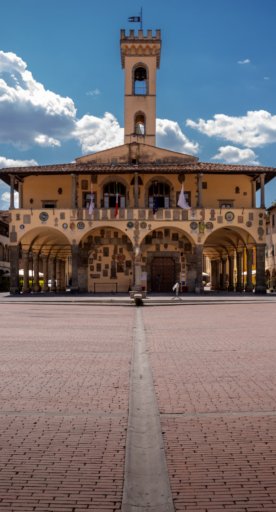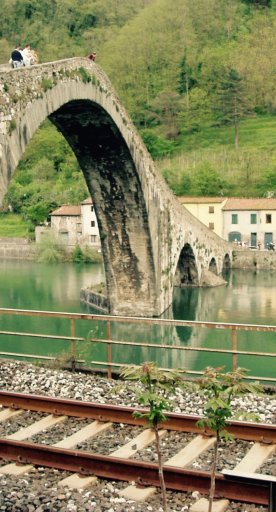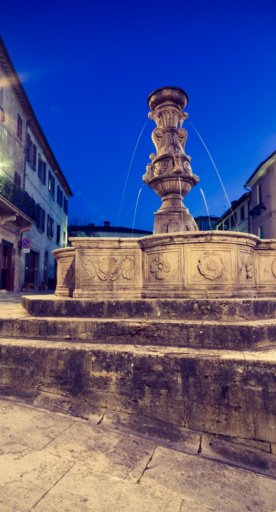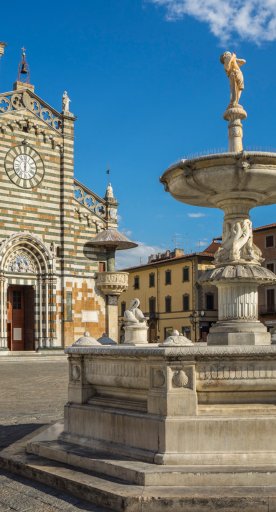Pistoia: what to see and do
The surprising sights of the historic town
You’ve seen Florence, Lucca and Pisa, but you simply cannot leave out Pistoia. Awaiting your arrival at the foot of the Tuscan Appennine Mountains and just 30 km from Florence, there are many treasures hidden in this intriguing city that was once the very centre of Gallic, Ligurian and Etruscan settlements. Then becoming a Roman colony, Pistoia played an important role in Roman troops’ battle against the Ligurians. Bearing traces of all this history as well as its medieval past, Pistoia boasts some of the most captivating museums within its walls as well as a packed cultural calendar that make it a sure choice on your visit to Tuscany.
-
1.What to see
-
2.What to do
-
3.Typical foods
What to see

Pistoia has a long-list of sights that you’ll want to spend weeks admiring. Here are some of the ones you will want to pin to your maps and make sure to catch a glimpse, embracing centuries of rich heritage.
At the very centre of the artistic and historic city of Pistoia is Piazza Duomo. The site of the biggest event in Pistoia’s calendar, Pistoia Blues, medieval buildings form an enticing circle embracing the space, making it a perfect venue. It’s also used to host the “Joust of the Bear”, another highly anticipated annual event explored in further detail later on in this article. In the square, an imposing bell tower stands at a proud height of 67 metres. Converted in the 13th century from a tower of the Lombard era, take a deep breath and climb the 200 steps to the top for an amazing panoramic view of the city.
Once you’ve had your fill of the incredible view, head back down to the Piazza to explore the magnificent Cathedral of San Zeno. The remarkable Romesque-Pisan building nestled in the very heart of the city dates back to c.1000 and offers a wonderful vantage point of the Piazza. With its white and green marble façade and marble statues of the city's patron saints, St. Zeno and St. James, there are many treasures within its glimmering walls, including impressive glazed terracotta by Andrea della Robbia. A peace and tranquility pervades as you soak up the special ambience.
Just to the side of the square and relatively hidden, you’ll find the Baptistery designed by Andrea Pisano and completed in the 14th century. Cocooned within is a Romanesque baptismal fond dating back to 1200. Once you’ve admired the intricately cut marble, exit and see the Bishop’s Palace just next door. Dated to 1091, the elaborate and fortified former residence of the Bishop of Pistoia now houses the Cathedral Museum where rare stratigraphic excavation prompts admiration.
The 13th century Town Hall gives further insight into the compelling past of this pleasant place. It now houses the civic museum, answering all the questions you may have about this historic city.

Delve deeper into the artistic treasures of Pistoia in Palazzo Rospigliosi. Home to the Rospigliosi and Diocesan Museums and the Lace Museum, this 16th-17th century Palazzo was the residence of the prestigious Rospigliosi family – of Pope Clement IX fame. The impressive artistic and liturgical collection within these elegantly decorated rooms with decadent and sumptuous furnishings creates a luxurious impact.
Continue on to the Basilica of the Madonna dell'Umiltà. Founded in 1495 by Giuliano da Sangallo, it was finished by no other than the noted art historian Giorgio Vasari. A staggering 59 metre-high cupola is gasp-inducing, and the decorations of the chapels, in part funded by the Rospigliosi family in the 1580s, include sacred images of great importance worthy of further exploration.
Enticing all those interested in art are the spectacular 14th-century frescoes in the Church of Tau. Intriguingly juxtapositioned against sculptures by Marino Marini, the appeal of this church lies in its significant restoration work which recovered many original structures and décor, including a crypt below and an outstanding late-Gothic fresco cycle.
The Romanesque Polychrome Church of San Giovanni Fuorcivitas is just outside the city of Pistoia and is thought to have been built by the Lombards upon their conversion to Catholicism in the 12th century. Blind arches, two rows of loggias, and an arch and architrave by Gruamonte are all features which strike visitors, not forgetting, of course, the long white and green horizontal lines in white and serpentine marble from Prato, splendidly adorning the exterior.
For something a little bit different and more modern, check out the Gori collection at the Fattoria di Celle, one of the most important outdoor art collections in Italy. Located in Santomato, a small hamlet in the municipality of Pistoia, the romantic surroundings of the villa and park, formerly the property of the nobel Fabbroni family, were reappropriated by entrepreneur and collector Giuliano Gori in 1982 when he transformed it into an open-air contemporary art museum. With about 80 monumental works by renowned artists including Claudio Parmeggiani, Mauro Staccioli, Jean-Michel Folon, Enrico Castellani, Sol LeWitt and Hidetoshi Nagasawa, this impressive site is a must for any visitor to Pistoia and opens your eyes to a whole other side of cultural creativity.
What to do

Once you’ve had your fill of the sites, it's time to witness some top-class performances. Drawing huge crowds each year is the Pistoia Blues international music festival. Rocking out beats annually since 1980, move to the groove of legendary performers of rock and blues in the magnificent setting of Piazza Duomo for an experience like no other. Change the pace again by heading to the “Joust of the Bear” (Giostra dell’Orso), a fascinating local tradition dating back as far as the 1300s when it was an annual recurrence until 1666. Resurrected in 1947, it takes place on July 25 to recreate the historic event.
Pistoia is also home to unusual museums of unique and fascinating features. Go beyond the usual exhibit and set off on underground tour at a museum like no other. The Pistoia Underground Museum places you right within the very labyrinth of Pistoia’s history. Below the historic centre of Pistoia lies a tunnel where the Brana river once flowed. Follow a guide as he illustrates the historical evolution of the Ospedale del Ceppo built in 1277 and still in practice, home to a famous frieze by the Della Robbia school. The oldest architectural remains of the city are discoverable here in about 650 metres of a winding path below the hospital.

Emerge back into the daylight having discovered and understood the history of the city. Incredibly, this archaeological site is the longest underground tour in Italy accessible to all, including those with disabilities or visual impairments. Not only is the mere site fascinating in and of itself, it is also home to an underground theatre that hosts concerts and readings.
Another one for your list is the Montagna Pistoiese EcoMuseum. A partly open-air museum with several sites, it is made up of outdoor itineraries, museums and education centers with the purpose of revealing the Tuscan Apennines to visitors and exploring the essential role of the landscape throughout history. Whether you take the Iron trail delving into the Middle Ages and the Medici, or head to the Stone learning centre, there awaits an insightful look at the environment’s fundamental role in the lives of all.
And finally, the Zoological Museum – the perfect spot for families and animal enthusiasts. see jaguars, polar bears, and an enormous python up close (but not too close!). Situated in the beautiful rolling hills around Pistoia since 1970, the vast space is home to over 600 animals as well as a planned conservation centre for endangered speices and environmental study.
Typical foods

Hungry after all that exploring? For a platter with a difference, try “carcerato” soup, the staple of prisoners. Yes, you read that right! The legend is that Pistoia’s slaughterhouse did not sell giblets, but instead tossed them in the Brana river. Seeing this, the Saint Catherine prison asked for permission to have the offal which they durned in to a soup, adding stale bread and water. You’ll be glad to hear that the recipe has vastly improved since, now being enriched with vegetables, spices and cheese, but the story of its origins is certainly an intriguing one!
For something with quite different origins, taste “Brigidini of Lamporecchio”. Thin, crispy and fragrant, these golden waffles are made with eggs, sugar, anise or fennel seeds and a popular street food, especially during fairs and festivals. These curly-shaped delightful treats will be sure to have you craving more!














































































